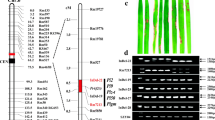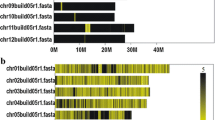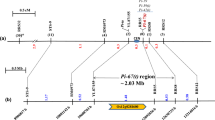Abstract
Rice blast disease caused by Magnaporthe grisea is a continuous threat to stable rice production worldwide. In a modernized agricultural system, the development of varieties with broad-spectrum and durable resistance to blast disease is essential for increased rice production and sustainability. In this study, a new gene is identified in the introgression line IR65482-4-136-2-2 that has inherited the resistance gene from an EE genome wild Oryza species, O. australiensis (Acc. 100882). Genetic and molecular analysis localized a major resistance gene, Pi40(t), on the short arm of chromosome 6, where four blast resistance genes (Piz, Piz-5, Piz-t, and Pi9) were also identified, flanked by the markers S2539 and RM3330. Through e-Landing, 14 BAC/PAC clones within the 1.81-Mb equivalent virtual contig were identified on Rice Pseudomolecule3. Highly stringent primer sets designed for 6 NBS-LRR motifs located within PAC clone P0649C11 facilitated high-resolution mapping of the new resistance gene, Pi40(t). Following association analysis and detailed haplotyping approaches, a DNA marker, 9871.T7E2b, was identified to be linked to the Pi40(t) gene at the 70 Kb chromosomal region, and differentiated the Pi40(t) gene from the LTH monogenic differential lines possessing genes Piz, Piz-5, Piz-t, and Pi-9. Pi40(t) was validated using the most virulent isolates of Korea as well as the Philippines, suggesting a broad spectrum for the resistance gene. Marker-assisted selection (MAS) and pathotyping of BC progenies having two japonica cultivar genetic backgrounds further supported the potential of the resistance gene in rice breeding. Our study based on new gene identification strategies provides insight into novel genetic resources for blast resistance as well as future studies on cloning and functional analysis of a blast resistance gene useful for rice improvement.




Similar content being viewed by others
References
Asaga K (1981) A procedure for evaluating field resistance to blast in rice varieties. J Cent Agric Stn 35:51–138
Bryan GT, Wu KS, Farrall L, Jia YL, Hershey HP, McAdams SA, Faulk KN, Donaldson GK, Tarchini R, Valent B (2000) A single amino acid difference distinguishes resistant and susceptible alleles of the rice blast resistance gene Pi-ta. Plant Cell 12:2033–2046
Campbell MA, Chen D, Ronald PC (2004) Development of co-dominant amplified polymorphic sequence markers in rice that flank the Magnaporthe grisea resistance gene Pi7(t) in recombinant inbred line 29. Phytophathology 94:302–307
Conaway-Bormans CA, Marchetti MA, Johnson CW, McClung AM, Park WD (2003) Molecular markers linked to the blast resistance gene Pi-z in rice for use in marker-assisted selection. Theor Appl Genet 107:1014–1020
Dean RA, Talbot NJ, Ebbole DJ, Farman ML (2005) The genome sequence of the rice blast fungus Magnaporthe grisea. Nature 434:980–986
Deng Y, Zhu X, Shen Y, He Z (2006) Genetic characterization and fine mapping of the blast resistance locus Pigm(t) tightly linked to Pi2 and Pi9 in a broad-spectrum resistant Chinese variety. Theor Appl Genet 113:705–713
Fukuoka S, Okuno K (2001) QTL analysis and mapping of pi21, a recessive gene for field resistance to rice blast in Japanese upland rice. Theor Appl Genet 103:185–190
Gowda M, Barman-Roy S, Chatoo BB (2006) Molecular mapping of a novel blast resistance gene Pi38 in rice using SSLP and AFLP markers. Plant Breed 125:596–599
Haldane JBS (1919) The combination of linkage values and the calculation of distances between the loci of linked factors. J Genet 8:299–309
Hayashi K, Hashimoto N, Daigen M, Ashikawa I (2004) Development of PCR-based SNP markers for rice blast resistance genes at the Piz locus. Theor Appl Genet 108:1212–1220
Hayashi K, Yoshida H, Ashikawa I (2006) Development of PCR-based allele-specific and InDel marker sets for nine rice blast resistance genes. Theor Appl Genet 113:251–260
Jena KK, Multani GS, Khush GS (1991) Monogenic alien addition lines of Oryza australiensis and alien gene transfer. Rice Genet II:728
Jena KK, Khush GS, Kochert G (1992) RFLP analysis of rice (Oryza sativa L.) introgression lines. Theor Appl Genet 84:109–118
Jena KK, Jeung JU, Lee JH, Choi HC, Brar DS (2006) High-resolution mapping of a new brown planthopper (BPH) resistance gene, Bph18(t) and marker-assisted selection for BPH resistance in rice (Oryza sativa L.). Theor Appl Genet 112:288–297
Jeung JU, Han SS, Cho YC, Hwang HG, Choi HC, Moon HP, Lee MH, Brar DS, MacKill DJ, Jena KK (2003) Identification of a new source of resistance to blast isolates of Korea in an alien introgression line of rice. Rice Genet Newslett 20:92–93
Jia Y, McAdams SA, Bryan GT, Hershey HP, Valent B (2000) Direct interaction of resistance gene and avirulence gene products confers rice blast resistance. EMBO J 19:4004–4014
Jiang J, Wang S (2002) Identification of a a118-kb DNA fragment containing the locus of blast resistance gene Pi-2(t) in rice. Mol Genet Genomics 268:249–252
Khush GS (2004) Feeding five billion rice consumers—the role of rice breeding. In: Lee KS, Jena KK, Heong KL (eds) Adv Rice Sci pp 3–15
Kim BR, Roh JH, Choi SH, Ahn SW, Han SS (2004) Durability of rice cultivars to blast in Korea by sequential planting method (in Korean). Korean J Breed 36:350–356
Lincoln S, Daly M, Lander ES (1992) Construction genetic maps with MAPMAKER/EXP 3.0. Whitehead Institute Technical Report, 3rd edn
Liu G., Lu G., Zeng L, Wang G.L (2002) Two broad-spectrum blast resistance genes, Pi9(t) and Pi2(t), are physically linked on rice chromosome 6. Mol Genet Genomics 267:472–480
Lu G, Jantasuriyarat C, Zhou B, Wang GL (2004) Isolation and characterization of novel defense response genes involved in compatible and incompatible interactions between rice and Magnaporthe grisea. Theor Appl Genet 108:525–534
Mackill DJ, Bonman JM (1992) Inheritance of blast resistance in near-isogenic lines of rice. Phytopathology 82:746–749
Martin GB, Bogdanove AJ, Sessa G (2003) Understanding the function of plant disease resistance proteins. Annu Rev Plant Biol 54:23–61
McCouch SR, Teytelman L, Xu YB, Lobos KB, Clare K, Walton M, Fu BY, Maghirang R, Li ZK, Xing YZ, Zhang QF, Kono I, Yano M, Fjellstom R, Declerck G, Scheider D, Cartinhour S, Ware D, Stein L (2002) Development and mapping of 2240 new SSR markers for rice (Oryza sativa L.). DNA Res 9:199–207
Monosi B, Wisser RJ, Pennill L, Hulbert SH (2004) Full-genome analysis of resistance gene homologues in rice. Theor Appl Genet 109:1434–1447
Murray MG, Thompson WF (1980) Rapid isolation of high molecular-weight plant DNA. Nucleic Acids Res 8:4321–4325
Ou SH (1985) Rice diseases, 2nd edn. Commonwealth Mycological Institute, Kew, Surrey, 380 pp
Remington DL, Thornsberry JM, Matsuoka Y, Wilson IM, Whitt SR, Doebley J, Kresovich S, Goodman MM, Buckler ES (2001) Structure of linkage disequilibrium and phenotypic associations in the maize genome. Proc Natl Acad Sci USA 98:11479–11484
SAS Institute (2000) SAS language and procedure: Usage, Release & 01. SAS Inst., Carry, NC
Sharma TR, Madhav MS, Singh BK, Shanker P, Jana TK, Dalal V, Pandit A, Singh A, Gaikwad K, Upreti HC, Singh NK (2005) High resolution mapping, cloning and molecular characterization of the PiK h gene of rice, which confers resistance to M. grisea Mol Gen Genomics 274:569–578
Song WG, Wang GL, Chen LL, Kim HK, Pi LY et al (1995) The rice disease resistance gene, Xa21, encodes a receptor-like protein kinase. Science 270:1804–1806
Sun XL, Cao YL, Yang ZF, Xu CG, Li XH, Wang SP, Zhang QF (2004) Xa26, a gene conferring resistance to Xanthomonas oryzae pv. oryzae in rice, encodes an LRR receptor kinase-like protein. Plant J 37:517–527
Tabien RE, Li Z, Paterson AH, Marchetti MA, Stansel JW, Pinson SRM (2002) Mapping QTLs for field resistance to the rice blast pathogen and evaluating their individual and combined utility in improved varieties. Theor Appl Genet 105:313–324
Tsunematsu H, Yanoria MJT, Ebron LA, Hayashi N, Ando I, Kato H, Imbe T, Khush GS (2000) Development of monogenic lines of rice blast resistance. Breeding Sci 50:229–234
Qu S, Liu G, Zhou B, Bellizzi M, Zeng L, Dai L, Han B, Wang GL (2006) The broad-spectrum blast resistance gene Pi9 encodes a nucleotide-binding site-leucine-rich repeat protein and is a member of a multigene family in rice. Genetics 172:1901–1914
Wang GL, Mackill DJ, Bonman JM, McCouch SR, Champox MC, Nelson RJ (1994) RFLP mapping of genes conferring complete and partial resistance to blast in a durably resistant rice cultivar. Genetics 136:1421–1434
Wang ZX, Yano M, Yamanouchi U, Iwamoto M, Monna L, Hayasaka H, Katayose Y, Sasaki T (1999) The Pib gene for rice blast resistance belongs to the nucleotide binding and leucine-rich repeat class of plant disease resistance genes. Plant J 19:55–64
Wang YM, Dong ZY, Zhang ZJ, Lin XY, Shen Y, Zhou D, Liu B (2005) Extensive de novo genomic variation in rice induced by introgression from wild rice (Zizamia latifola Griseb.). Genetics 170:1945–1956
Wei F, Wing RA, Wise RP (2002) Genome dynamics and evolution of the Mla (powdery mildew) resistance locus in barley. Plant Cell 14:1903–1917
Wing RA, Ammiraju JSS, Luo M, Kim HR, Yu Y, Kudrna D, Goicoechea JL et al (2005) The Oryza map alignment project: the golden path to unlocking the genetic potential of wild species. Plant Mol Biol 59:53–62
Zeigler RS, Thome J, Nelson J, Levy M, Correa-Victoria FJ (1994) Lineage exclusion: a proposal for linking blast population analysis to resistance breeding. Rice blast disease. CAB International, Wallingford, pp 267–292
Zhou T, Wang Y, Chen JQ, Araki H, Jing Z, Jiang K, Shen J, Tian D (2004) Genome-wide identification of NBS genes in japonica rice reveals significant expansion of divergent non-TIR NBS-LRR genes. Mol Gen Genomics 271:402–415
Zhou B, Qu S, Liu G, Dolan M, Sakai H, Lu G, Bellizzi M, Wang GL (2006) The eight aminoacid differences within three leucine-rich repeats between Pi2 and Piz-t resistance proteins determine the resistance specificity to Magnaporthe grisea. Mol Plant Microbe Interact 19:1216–1228
Zhou B, Dolan M, Sakai H, Wang GL (2007) The genomic dynamics and evolutionary mechanism of the Pi2/9 locus in rice. Mol Plant Microbe Interact 20:63–71
Acknowledgments
We are grateful to the Rural Development Administration (RDA), Suwon, Korea, for financial support for this study. We thank Darshan S. Brar (plant breeder, IRRI) and Guo-Liang Wang, Ohio State University, USA for critical review of the manuscript, Y. Fukuta (plant breeder, IRRI) for providing blast monogenic differential lines and C. M. Veracruz (plant pathologist, IRRI) for evaluating the lines against Philippines blast isolates. We are thankful to Ms. Kang Min-Hae for technical assistance and Bill Hardy (science editor, IRRI) for editing the manuscript.
Author information
Authors and Affiliations
Corresponding author
Additional information
Communicated by T. Sasaki
Rights and permissions
About this article
Cite this article
Jeung, J.U., Kim, B.R., Cho, Y.C. et al. A novel gene, Pi40(t), linked to the DNA markers derived from NBS-LRR motifs confers broad spectrum of blast resistance in rice. Theor Appl Genet 115, 1163–1177 (2007). https://doi.org/10.1007/s00122-007-0642-x
Received:
Accepted:
Published:
Issue Date:
DOI: https://doi.org/10.1007/s00122-007-0642-x




